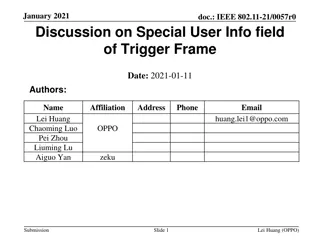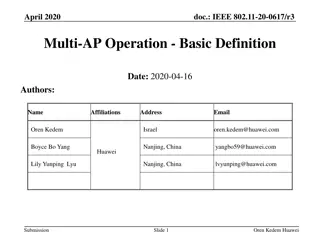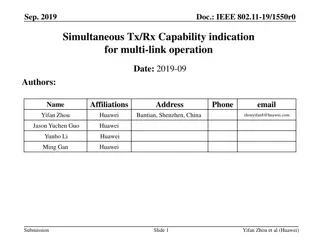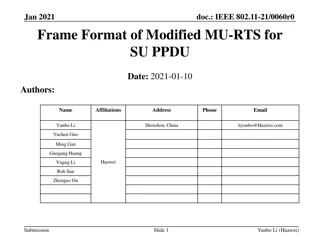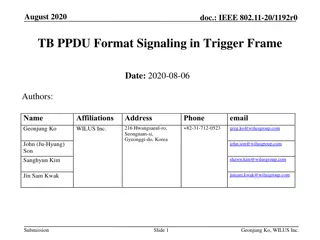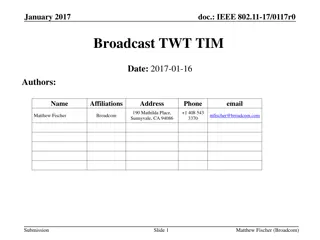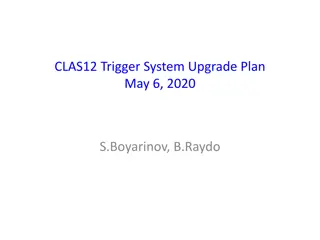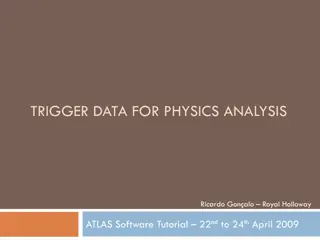Multi-RU Indication in Trigger Frame for IEEE 802.11
This document discusses the concept of Multi-RU (Resource Unit) allocation in trigger frames for IEEE 802.11 standards, specifically focusing on the indication methods within trigger frames for improved spectral efficiency. The proposal suggests various options for indicating multiple RUs in trigger frames, enhancing resource allocation and transmission efficiency for high-speed wireless networks.
Download Presentation

Please find below an Image/Link to download the presentation.
The content on the website is provided AS IS for your information and personal use only. It may not be sold, licensed, or shared on other websites without obtaining consent from the author.If you encounter any issues during the download, it is possible that the publisher has removed the file from their server.
You are allowed to download the files provided on this website for personal or commercial use, subject to the condition that they are used lawfully. All files are the property of their respective owners.
The content on the website is provided AS IS for your information and personal use only. It may not be sold, licensed, or shared on other websites without obtaining consent from the author.
E N D
Presentation Transcript
March 2020 doc.: IEEE 802.11-20/0416r0 Multi-RU Indication in Trigger Frame Date: 2020-03-12 Authors: Affiliations Address Phone email Name Mengshi Hu humengshi@Huawei.com Huawei Ross Jian Yu ross.yujian@huawei.com Huawei Ming Gan Huawei Submission Slide 1 Mengshi Hu, et al Huawei Technologies
March 2020 doc.: IEEE 802.11-20/0416r0 Background Multi-RU Multi-RU means more than one RU can be assigned to a single STA [1][2]. 11ax does not support multi-RU combination and assignment 11be shall support multi-RU for higher spectral efficiency Recently, several motions on multi-RU combination have been passed, including small RU combination and large RU combination [3][4] Small RU: RUs with size smaller than 242 Large RU: RUs with size equal to or lager than 242 Although several signaling options on multi-RU have been discussed, these options mainly focus on the solutions for non-TB PPDU [5]. In this proposal, we focus on the trigger frame and discuss the multi-RU Indication in it. Submission Slide 2 Mengshi Hu, et al Huawei Technologies
March 2020 doc.: IEEE 802.11-20/0416r0 Format of Trigger Frame Trigger Frame A trigger frame allocates resources for and solicits one or more TB PPDU transmissions. The User Info List field contains zero or more User Info fields. Each User Info field contains an RU Allocation subfield. The RU Allocation subfield along with the UL BW subfield in the Common Info field identifies the size and location of the RU. One STA is corresponding to one User Info field. Frame Control Common Info User Info List Duration RA TA Padding FCS ... User Info User Info User Info RU ... AID12 Allocation Trigger Frame Format Submission Slide 3 Mengshi Hu, et al Huawei Technologies
March 2020 doc.: IEEE 802.11-20/0416r0 RU allocation subfield for 240/320 MHz BW Similar method is assumed to be used for an 11be trigger frame. For 240MHz/320MHz, a 9-bit RU-Allocation subfield can be used. The mapping of B1-B0 of the RU Allocation subfield is shown in the following table, which indicates an 80MHz segment in 240Mhz/320MHz BW. Descriptions BW RU Allocation subfield (B1,B0) Only one 80MHz segment 20MHz, 40MHz and 80MHz 00 160MHz or 80+80MHz 00, 01 00: lower segment, 01: higher segment 240MHz 00, 01, 10 Three segment 320MHz, 160+160MHz 00, 01, 10, 11 Four segment In the following, we propose several multi-RU indication options on the basis of the existing format. Submission Slide 4 Mengshi Hu, et al Huawei Technologies
March 2020 doc.: IEEE 802.11-20/0416r0 Opt 1: Repeat AID If an AP wants to allocate N RUs for one STA, we could directly use N user Info fields to indicate these N RUs. Each User Info fields contains the same AID. Some considerations User Info fields with the same AID could be put together to save energy An end indication could be added to each user field to denote whether it belongs to a same STA etc. Frame Control Common Info User Info List Duration RA TA Padding FCS ... User Info User Info User Info STA 1 STA 1 STA x allocated to the same STA Opt 1: Repeat AID Submission Slide 5 Mengshi Hu, et al Huawei Technologies
March 2020 doc.: IEEE 802.11-20/0416r0 Opt 2: Combination Indication Although less specification impact is achieved by Opt 1, the first option needs more than one User Info field to indicate multi-RU combination. Opt 2: A Combination Indication subfield can be added to each User Info field to denote the multi-RU combination. Different combinations can be distinguished by this subfield along with the RU Allocation subfield. Frame Control Common Info User Info List Duration RA TA Padding FCS ... User Info User Info User Info RU Allocation Subfield Combination Indication AID12 ... 12 bits 9 bits Several bits Opt 2: Combination indication Submission Slide 6 Mengshi Hu, et al Huawei Technologies
March 2020 doc.: IEEE 802.11-20/0416r0 Opt 2: Combination Indication For example, to indicate the 52+26 combination case, we could let the RU Allocation subfield in User Info field point at the location of the 52- tone RU (the larger/largest one). Then by using the following table, we can get the exact 52+26 combination. Combination Ind Bit 1 RU Meaning allocation Bit 0 0 0 52-tone RU only, no multi-RU combination 2nd 52- tone RU (e.g.) 0 1 52 + 26 (on the left, contiguous) 1 0 52 + 26 (on the right, contiguous) 1 1 Reserved Same for 106-tone RU + 26-tone RU combination. Submission Slide 7 Mengshi Hu, et al Huawei Technologies
March 2020 doc.: IEEE 802.11-20/0416r0 Opt 2: Combination Indication Another example is about large RU combination, e.g., to indicate 484+242 combination case, we could let the RU Allocation subfield in User Info field point at the location of the 484-tone RU (the larger/largest one). Then by using the following table, we can get the exact 484+242 combination. Combination Ind Bit 1 RU Meaning allocation Bit 0 0 0 484-tone RU only, no multi-RU combination 1st 484- tone RU (e.g.) 0 1 484 + 242 (contiguous) 1 0 484 + 242 (non-contiguous) 1 1 Reserved Other combinations of multi-RU could follow the same rules. To indicate more flexible combination (e.g., for RU combinations across 80MHz), we could either use larger bitwidth, or this option can be combined with Opt 1, which means that more than one User Info field can be used. Submission Slide 8 Mengshi Hu, et al Huawei Technologies
March 2020 doc.: IEEE 802.11-20/0416r0 Opt 3: Change in RU Allocation subfield To indicate different multi-RU combinations, new entries can be added to the RU Allocation subfield. An example of the mapping of B8-B2 in RU Allocation subfield is shown in the following table. Some newly added entries are added in this table to show the MRU combinations related to this 80MHz segment. B8-B2 Description Number of entries 26-tone RU in 80MHz 37 0-36 52-tone RU in 80MHz 16 37-52 106-tone RU in 80MHz 8 53-60 242-tone RU in 80MHz 4 61-64 484-tone RU in 80MHz 2 65-66 996-tone RU in 80MHz 1 67 Two 996-tone RUs 3 68-70 Three 996-tone RUs 3 71-73 Four 996-tone RUs 1 74 In 80MHz, the lower/upper 106-tone RU and the middle 26-tone RU in a 20MHz In an 80MHz, the secondary lower/upper 52-tone RU and the 26-tone RU on the same side in a 20MHz In an 80MHz, a 484-tone RU and a contiguous 242-tone RU 8 75-82 83-90 8 91-92 2 93-94 In an 80MHz, a 484-tone RU and a non-contiguous 242-tone RU 2 Submission Slide 9 Mengshi Hu, et al Huawei Technologies
March 2020 doc.: IEEE 802.11-20/0416r0 RU combination indication for non- OFDMA TB PPDU For non-OFDMA TB PPDU, the number of RU combination modes may be larger than the number for OFDMA case. May first indicate the trigger frame is for non-OFDMA TB PPDU, and then use similar indication method as the indication in the EHT-SIG of a non-TB PPDU. Specific signaling methods will be discussed separately. Submission Slide 10 Mengshi Hu, et al Huawei Technologies
March 2020 doc.: IEEE 802.11-20/0416r0 Summary Options Pros Cons 1. 2. Less specification impact Very flexible combination 1. A multi-RU user needs more than one User Info field (high overhead) Option 1 Repeat AID in the User Info field allocated to the same STA 1. For most cases, one STA only needs one User Info field (More User Info fields are needed to support more flexible combinations) 1. Needs to add a Combination Indication subfield in each User Info field (medium overhead) Option 2 (Preferred) Combination Indication in each User Info field 1. One STA only needs one User Info field (no additional overhead) 1. More entries in the RU allocation subfield Option 3 (Preferred) Change in the RU Allocation subfield Submission Slide 11 Mengshi Hu, et al Huawei Technologies
March 2020 doc.: IEEE 802.11-20/0416r0 Straw Poll #1 Do you agree to the bitwidth of the RU allocation subfield in the trigger frame is 9 bit? And B1, B0 of the RU allocation subfield are used to indicate which 80Mhz the RU allocation subfield applies to? Submission Slide 12 Mengshi Hu, et al Huawei Technologies
March 2020 doc.: IEEE 802.11-20/0416r0 Straw Poll #2 Which option do you prefer to be used for RU combination indication in the trigger frame? Non-OFDMA mode TBD Descriptions Options Option 1 Repeat AID in the User Info field allocated to the same STA Combination Indication in each User Info field Option 2 Option 3 Change in the RU Allocation subfield Opt1 Opt2 Opt3 None Abstain Submission Slide 13 Mengshi Hu, et al Huawei Technologies
March 2020 doc.: IEEE 802.11-20/0416r0 References [1] IEEE 802.11-19/1126r1 Enhanced Resource Unit Allocation Schemes for 11be [2] IEEE 802.11-19/1914r4 Multiple RU Discussion [3] IEEE 802.11-19/1907r2 Multiple RU Combinations for EHT [4] IEEE 802.11-19/1908r4 Multi-RU Support [5] IEEE 802.11-19/1968r2 Signaling Support for Multi-RU Assignment Submission Slide 14 Mengshi Hu, et al Huawei Technologies




